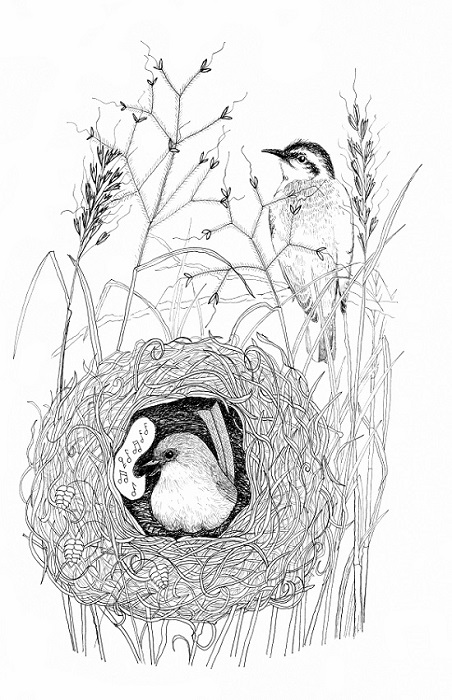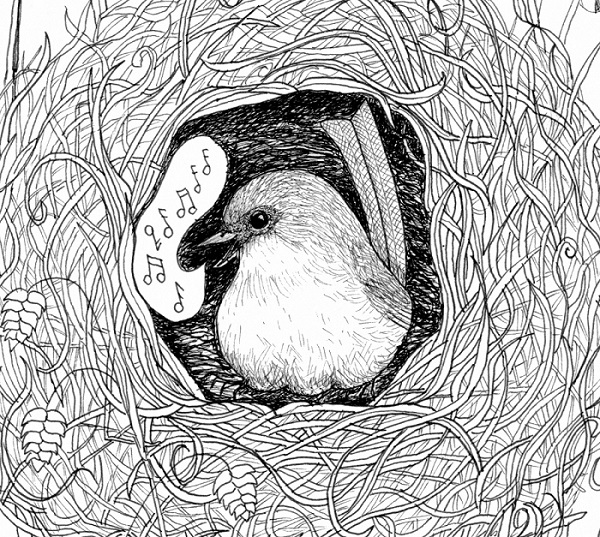
Fairy-wren and cuckoo. Pen and ink drawing by Paula Peeters.
A pair of fairy wrens are in our garden – their calls are shrill, sweet and curiously penetrating. And for the first time ever, I think they might stay. This is terribly exciting. When we moved here eight years ago, we transformed a backyard of kikuyu grass into a small tangled oasis of native plants, deliberately planted thickly to entice small birds. Our street has mostly old-style Brisbane yards: mowed lawn with the odd tree or shrub, and the birdlife is dominated by magpies, butcherbirds, and the local gang of noisy miners.
Now two drab little fairy-wrens, a female and a non-breeding male, are hopping from twig to twig in our backyard. They pounce on insects as they go, trilling almost continuously. Shouldn’t they hush? The neighbourhood bully-birds will surely hear them, and chase them away. But maybe the fairy-wrens’ need to keep in contact with each other (and perhaps share a lively conversation about this new place) outweighs the risk of being detected? After all, a fairy-wren’s song helps it to survive while still a naked babe in the nest, and it learns its first call while still in the egg.
Female superb fairy-wrens sing to their eggs, while sitting in the nest. This seems like an odd thing to do, as calling from the nest would make it more obvious to predators, and also to cuckoos who regularly parasitise fairy-wrens. Are their advantages of singing on the nest that outweigh the risk of attracting predators and parasites?
To find out, researchers in South Australia¹ recorded the song of female fairy-wrens on the nest, and also recorded the songs of the chicks. They noticed that each mother had a slightly different call. But what was even more fascinating, was that the begging calls of chicks included song elements that were most similar to the calls of the mother wren. By swapping eggs between nests, they showed that the chick’s calls were not inherited genetically, they were learnt. The chicks were learning how to sing from the female wren who reared them.
But, as suspected, some of eggs were eaten by predators – especially currawongs and ravens. Horsfield’s bronze cuckoos had been active too, surreptitiously leaving their eggs in some fairy-wren nests. But that’s when things started to get really interesting.
Over a series of experiments and observations, the researchers discovered something astonishing. The fairy-wren chicks were learning the mother’s call while still in the egg. And when they hatched, the chicks that could mimic the mother’s call most faithfully were the ones that received the most food. Chicks that sung the mother’s song poorly, or not at all, received less food.
Cuckoos were unable to learn the fairy-wren mother’s call while developing in the egg. Once hatched, the cuckoo chick had to learn very quickly how to imitate the fairy-wren begging call. If it didn’t learn to modify its call quickly enough, it would be abandoned by the fairy-wren parents, even if it was the only chick left in the nest. So the lullabies sung by the mother fairy-wren over her eggs turned out to be vital to the survival of her chicks.
The more the female fairy-wren called to her eggs, the higher the similarity between the chicks’ and the mother’s calls. The female fairy-wrens also called to their eggs more often when a cuckoo call was heard near the nest. Male fairy-wrens also learnt the begging call from the female fairy-wren, and would preferentially feed the chicks who gave the correct begging call. Song-learning before hatching has been demonstrated for all other fairy-wren species that have been studied.
So as I listen to the fairy-wrens singing in my garden, I wonder if I’m hearing song phrases that were learnt while still in the egg. Perhaps these little birds have stayed together and survived this far – across the suburban wasteland – because they understand the importance of song for their survival. I can only hope that the female will one day sing lullabies of life over her own eggs, from a nest hidden deep in the scrubby nether regions of our yard.
-
References:
Colombelli-Négrel, D., Hauber, M. E., Robertson, J., Sulloway, F. J., Hoi, H., Griggio, M., & Kleindorfer, S. (2012). Embryonic learning of vocal passwords in superb fairy-wrens reveals intruder cuckoo nestlings. Current Biology, 22(22), 2155-2160.
Kleindorfer, S. (2015) The ecology of embryonic learning: costs and benefits of vocal tutoring in fragmented habitat. Presentation at the Ecological Society of Australia Conference, Adelaide.
This article was reprinted in the June 2016 edition of Australian Birdlife.


Great post Paula, especially the fairy wren egg-singing. I’ve spent time watching these birds and listening to their high pitched calls but this was new to me. John Read ‘whistled’ wrens on our recent trip to APY Lands, I was amazed how quickly they arrived. The bottom of this post https://artlikker.wordpress.com/2015/12/13/of-cukoos-and-a-marsupial-mice/ shows a fledgling cuckoo surrounded by wrens, Bendigo in November . As I sat it came within 2meters of me, intent on eating hairy caterpillars, like egg-singing, total magic.
Hey Peter, yes I was thrilled when I heard this fascinating tale at the Ecological Society of Australia conference last December, and knew I had to celebrate it in words and pictures somehow. When we come across fairy-wrens on walks we always stand very still and make little squeaky noises (sort of like kissing noises, with puckered lips) and the wrens usually come up and check us out, wondering who the strange lumbering humans with the high pitched voices are! Do you know if the long, sort of hook-tipped cuckoo beak is related to their diet of caterpillars? Cheers, Paula
Hi Paula, wish I could answer your cuckoo beak enquiry but when it comes to ecology I’m very much a beginner. I was just fortunate to be in the right place at the right time re hairy cuckoo food. Did you notice any work by artists at the conference? see https://artefactconservation.wordpress.com/projects-2/phascogale-and-departure-lounge/
Hey Peter, it was great to see your artwork and that of other artists in the conference handbook. It’s exciting that more people are combining art, science and environmental concerns in this country. Cheers, Paula
Wow! Fascinating insights into urban bird life. I am fascinated by the research on females singing to their eggs and the possible survival value of this strategy.
However, I am even more interested in your success in creating backyard small bird habitat. We did our first dedicated small bird habitat planting in 2015 and I have been explaining to people that it will be some years before it will be ready to attract the local Fairy Wrens and Red Browed Finches. Part of our objective in this planting is to demonstrate what can be done in a backyard and now we have more evidence from your experience.
Michael Fox
Mt Gravatt Environment Group
Hi Michael, our backyard bird habitat continues to be a work in progress, as the fairy-wrens are not permanent residents yet – they seem to come and go. But it’s encouraging to have regular visits by small birds, (including the rufous fantail who stayed for a day a couple of years ago) and we have plans for more sections of the garden that could be thickened up! But converting some neighbouring backyards would help too. I hope your small bird habitat is closer to bushland, so you have a better starting point? (I really must come out to Mt Gravatt to check it out). Cheers, Paula
This is such a beautiful observation. We, too, in Central Victoria have done some revegetation work partly aimed at recreating bird habitat. The acacias, correas and emu bushes planted near the house and connected to waterways by a vegetation corridor of acacias, appear to have created safe pathways between larger bodies of water to food supplies and smaller birdbaths that little birds revel in for drinking and bathing. It is one of our sheer joys to watch their antics. It seems having multiple sources of food and water increases the cooperation among the birds. They all seem to take turns. Although, I have even seen honeyeaters, white-browed babblers and a willy wagtail work together to steer a wattlebird clear of the water and food sources. Tha fairy wrens moved in about 2-3 years ago, adopting some low growing rambling bushes near the birdbath as their habitat and regularly foraging on the leaf litter that once was our lawn. They constantly sing and twitter to each other, regularly cleaning up the spider webs and fallen insects from around our windows and mud-brick walls. I have yet to find their nesting sites. Sounds like some wonderful woodland recreation is happening out there. Although our first directing seeding revegetation project failed, our second was successful, not as diverse as tangled backyards! Planting the correas and installing birdbaths appeared to give quicker results, although local birdos assure me it is the whole picture that birds respond to. Listening Earth do some wonderful bird sound recordings from around the world, from their base here.
Thank you for a wonderful blog and the comments.
A couple of other sites people may find useful are http://www.connectingcountry.org.au This group focuses on the Central Victorian region and offers a terrific education program about revegetation and woodland birds. They are committed to creating citizen scientists and their education program program includes lots of online information. Again in our local area is a bird blog of sightings, which today posted a marvellous series of photos of mistletoe birds feeding nestlings. https://geoffpark.wordpress.com/2016/01/07/mistletoebird-magic/
Be just lovely to see a series of photos of fairy wrens, their nests and young.
Hi Saide, thankyou for your kind words about my blog, and your care for, and interest in small birds . I think water is very important, especially birdbaths that have shallow edges and nearby perches that allow a range of birds to line up and use them. We have a family property in the southern Fleurieu Peninsula of South Australia, and have had great delight seeing a number of small bird species become permanent residents in response the the gradual revegetation that’s been done over the years. And a vital addition was a small, shallow-edged birdbath that is supplied with a float-valve and fitted to a rainwater tank. This way, the birds have permanent water all year round, including when we are away (and like perching on the float-arm too!). It’s good to keep in mind that a supply of permanent water is not good for some arid-land birds, as it encourages some competitive species e.g. Galahs. However, most of us, and our backyards, are not in these areas, and the provision of water is a simple and highly welcome service we can provide for birds (and snakes, frogs, etc…). Thanks for reading and commenting! Cheers, Paula
Great article, thank you Paula.
We are about to embark on attempting to reintroduce blue wrens back to our bush block in Central Victoria. We are fortunate to have an abundance of birds, but the smaller species have been scarce since we built our house. I fear we may disturbed the understory and the blue wrens that were quite prolific, even when were building, have since moved on. (Thankfully, just the other week I did notice a couple who had come back for a look-see!)
Like Michael, I was intrigued to learn that you have had some success at re-establishing an environment that the wrens are happy to once again inhabit. The sound of their call and antics amongst the vegetation brings much pleasure and delight and I can only hope that we too have some success in re-introducing them here. Thanks again.
Hi Dean, thanks for reading and commenting. As I replied to Michael, we’re not quite there yet, as the fairy-wrens seem to come and go, but hopefully it’s a matter of time. It sounds like that’s the case for you too, especially as the blue wrens were living at your place previously. I wonder how much habitat they need? I’m sure someone has measured this… So keep planting, and I’m sure they’ll move back in soon. I’m always encouraged by the fairy-wrens that seem to be permanent residents in seemingly inhospitable places – like the ones I used to see in the Melbourne Botanic Gardens (are they still there?) and the ones that hop around in front of the Gallery of Modern Art in Brisbane (where I write this now). Cheers, Paula
This is such an inspiring post Paula!
I am about to start planning a garden to attract birds and wondered if you have any pointers as you seem to have had some success. Any tips on species, the structure of planting or even a photo would be invaluable. Best of luck in keeping your visitors on a permanent basis.
Hi Eleanor, thanks for reading – I’m glad you enjoyed it! As for birdscaping tips, well the plant species would depend on the size of your garden, where you live (local species are generally best), and also what sort of birds you’d like to attract. In many places it’s relatively easy to attract honeyeaters and lorikeets by planting species that bear large showy flowers that produce lots of nectar (e.g. Grevilleas and Callistemons (bottlebrushes)). But if you want small insect-eating birds like fairy-wrens then it’s best to plant dense shrubby plants with smaller white flowers, and small seed-eaters like finches would benefit from grasses that are left to grow tall and produce seed. For more details see this guide: http://www.habitatnetwork.org/Planting%20Habitat%20Haven%20A4%205.pdf created by the Habitat Network (http://www.habitatnetwork.org/#H2 ) – but keep in mind it includes plant species for the Sydney area. Cheers, Paula
Paula, your drawings are just getting so good…I love your rufous fantail…keep it up…love reading about your observations of nature…so light-hearted and lovely…feel like am there seeing it all with you. Thankyou.
Hey Sue, thanks again for the lovely encouragement, I really appreciate it :). Cheers, Paula
Lovely post Paula and congratulations on creating a suburban habitat attracting fairy-wrens! They’re lovely little creatures, so delicate. I often see them in the foreshore shrubs along Palm Beach on the Gold Coast. There are quite a few little families along that stretch of beach all the way north to Tallebudgera Creek. I love stopping to watch them and now I’ll understand where their beautiful song begins. Thanks!
Thanks Gail. It’s great that so much research has been done on fairy-wrens so we know quite a bit about their behaviour and biology, e.g. they are also terribly promiscuous. So even such tiny, delicate birds have really quite complicated lives. I’m looking forward to more interesting bird stories coming out of avian research in Australia.